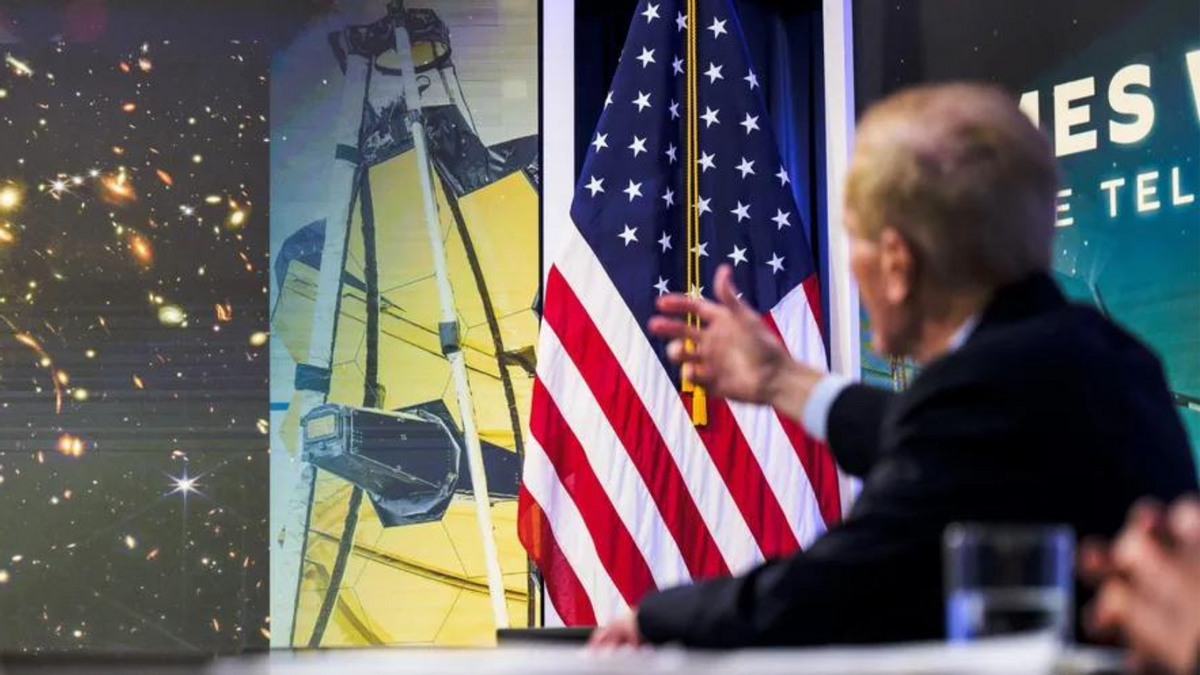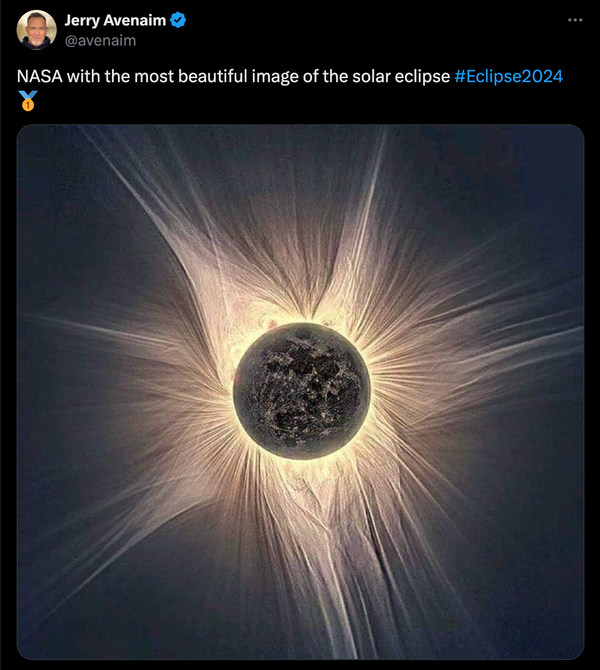Fact Check: Most Stunning Photo of the 'April 2024 Solar Eclipse' Was Taken in 2017. Here's What We Mean

Claim:
A real photo captured by NASA's James Webb Space Telescope (JWST) shows the April 8, 2024, solar eclipse.
Rating:
Context:
This is a digital drawing that recreates a real photo. That real photo was not taken by JWST, nor was it taken in 2024.
Perhaps the best part about a total solar eclipse, other than actually seeing it yourself in real time, is looking at some of the absolutely stunning photographs of it that circulate on social media.
Following the eclipse that arced across North America on April 8, 2024, posts on X (formerly Twitter) went viral, claiming that NASA's very own James Webb Space Telescope (JWST) had the best pic.

(X user @avenaim)
Snopes investigated the origin of the photo at the request of readers. We are happy to confirm that the photograph itself is real. However, it was not taken by NASA's JWST, nor was it taken during the April 8, 2024, eclipse. Here's what we found out:
First, we investigated social media profiles from NASA and JWST — we figured that the scientists and astronomers who took the photo would be proud of the telescope's capture and post about it.
Count us out of this! Webb's infrared optics detect extremely faint heat signals, and the Earth, Moon, and Sun are *all* much too bright and hot for us to ever look their way. It's why we have a sunshield: https://t.co/tTGIWqFAz8 https://t.co/wRTZNO4i6u
— NASA Webb Telescope (@NASAWebb) April 3, 2024
Instead, we found posts from the official JWST X account explaining that the Webb telescope cannot look at the sun, because it was designed to detect and view much, much fainter signals. JWST was designed with a sunshield specifically to block sunlight from interfering with the instruments. This means that the photo could never have been taken by Webb.
Next, we ran the photo through reverse-image search engines like TinEye and Google Lens, which provided us with mixed results. While TinEye found no matches, Google Lens came up with several, many of which, we noted, were posted before the eclipse on April 8. So, in addition to not being from JWST, the photo isn't of the 2024 North American solar eclipse.
It does actually show a solar eclipse in North America — it's just the one that happened on Aug. 21, 2017. Several of the links provided by the Google Lens search credited the image to Dr. Sebastian Voltmer, a filmmaker and astrophotographer.
By looking at Voltmer's social media, we immediately confirmed he took the original photo, with the best version of the photo coming from his Flickr page. According to the details provided in the Flickr caption, Voltmer captured the image through a telescope in Wyoming using a photographic technique called HDR, which combines several different images taken with different exposure lengths to best capture detail in images with high light/dark contrast.
When Voltmer posted the photo to social media, he rotated it 90 degrees to fit a vertical aspect ratio.
Total Solar Eclipse HDR image, captured with my D800 through a C80 ED refractor telescope.
Even with the naked eye, I was able to see the earthshineas I looked at the star Regulus (peripheral vision).
Image: @SeVoSpace
On April 8, the great total solar eclipse will cross North… pic.twitter.com/DJYz8UjWPs— Dr. Sebastian Voltmer (@SeVoSpace) April 6, 2024
When it was reposted after the 2024 eclipse with the false claim that it was taken by JWST, the vertical version of the photo was mirrored and likely filtered, which may be why reverse-image search sites like TinEye had trouble detecting it.
So, no, the photograph in question was not taken by the James Webb Space Telescope. However, don't think of it as a discredit on the limitations of JWST — instead, think of it more as a credit to both the telescope, which has changed our perception of astronomical imaging ever since its launch, and astrophotographers like Voltmer, who managed to take an absolutely stunning photo from the Earth's surface.
Sources:
"ABOUT." Website by Dr. Sebastian Voltmer, 14 July 2011, https://voltmer.de/about/.
Cole, Margherita. "Artist Spends 10 Days Recreating the Spectacular Sight of a Solar Eclipse." My Modern Met, 1 Feb. 2021, https://mymodernmet.com/cathrin-machin-solar-eclipse-digital-painting/.
"Https://Twitter.Com/Avenaim/Status/1777442521209282862/Photo/1." X (Formerly Twitter), https://twitter.com/avenaim/status/1777442521209282862/photo/1. Accessed 9 Apr. 2024.
"Https://Twitter.Com/NASAWebb/Status/1775629331357642755." X (Formerly Twitter), https://twitter.com/NASAWebb/status/1775629331357642755. Accessed 9 Apr. 2024.
"Https://Twitter.Com/SeVoSpace/Status/1776736821617319995." X (Formerly Twitter), https://twitter.com/SeVoSpace/status/1776736821617319995. Accessed 9 Apr. 2024.
Instagram. https://www.instagram.com/p/C5b41osy-C2/?hl=en. Accessed 9 Apr. 2024.
Instagram. https://www.instagram.com/p/CC3S10SgYoc/?img_index=1. Accessed 11 Apr. 2024.
The Sunshield Webb/NASA. https://webb.nasa.gov/content/observatory/sunshield.html. Accessed 9 Apr. 2024.
TinEye Reverse Image Search. https://tineye.com/search/ea998d3f04d504ce8c8ace8ca9be5800e321d6e0?sort=score&order=desc&page=1. Accessed 9 Apr. 2024.
Voltmer, Sebastian. Corona Earthshine 2017. photo, 6 Sept. 2017. Flickr, https://www.flickr.com/photos/spacemovie/36659081780/.
Updates:
April 11, 2024: This story was updated to reflect additional research that showed the viral image was a digital drawing that recreated the 2017 photo taken by Sebastian Voltmer.


